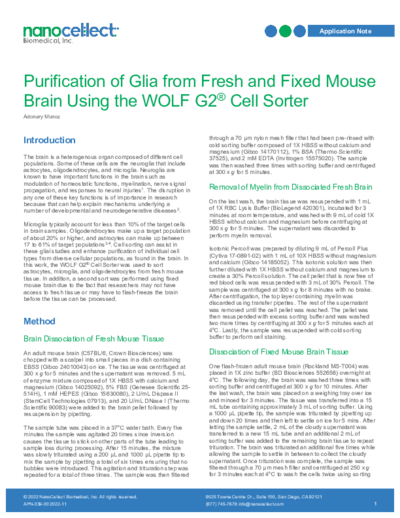Purification of Glia from Fresh and Fixed Mouse Brain Using the WOLF G2® Cell Sorter
Introduction
The brain is a heterogenous organ composed of different cell populations. Some of these cells are the neuroglia that include astrocytes, oligodendrocytes, and microglia. Neuroglia are known to have important functions in the brain such as modulation of homeostatic functions, myelination, nerve signal propagation, and responses to neural injuries1. The disruption in any one of these key functions is of importance in research because that can help explain mechanisms underlying a number of developmental and neurodegenerative diseases2.
Microglia typically account for less than 10% of the target cells in brain samples. Oligodendrocytes make up a target population of about 20% or higher, and astrocytes can make up between 17 to 61% of target populations3,4. Cell sorting can assist in these glial studies and enhance purification of individual cell types from diverse cellular populations, as found in the brain. In this work, the WOLF G2® Cell Sorter was used to sort astrocytes, microglia, and oligodendrocytes from fresh mouse tissue. In addition, a second sort was performed using fixed mouse brain due to the fact that researchers may not have access to fresh tissue or may have to flash-freeze the brain before the tissue can be processed.
Method
Brain Dissociation of Fresh Mouse Tissue
An adult mouse brain (C57BL/6, Crown Biosciences) was chopped with a scalpel into small pieces in a dish containing EBSS (Gibco 24010043) on ice. The tissue was centrifuged at 300 x g for 5 minutes and the supernatant was removed. 5 mL of enzyme mixture composed of 1X HBSS with calcium and magnesium (Gibco 14025092), 5% FBS (Genesee Scientific 25-514H), 1 mM HEPES (Gibco 15630080), 2 U/mL Dispase II (StemCell Technologies 07913), and 20 U/mL DNase I (Thermo Scientific 90083) were added to the brain pellet followed by resuspension by pipetting.
The sample tube was placed in a 37°C water bath. Every five minutes the sample was agitated 20 times since inversion causes the tissue to stick on other parts of the tube leading to sample loss during processing. After 15 minutes, the mixture was slowly triturated using a 200 μL and 1000 μL pipette tip to mix the sample by pipetting a total of six times ensuring that no bubbles were introduced. This agitation and trituration step was repeated for a total of three times. The sample was then filtered ...
Want to read more?

